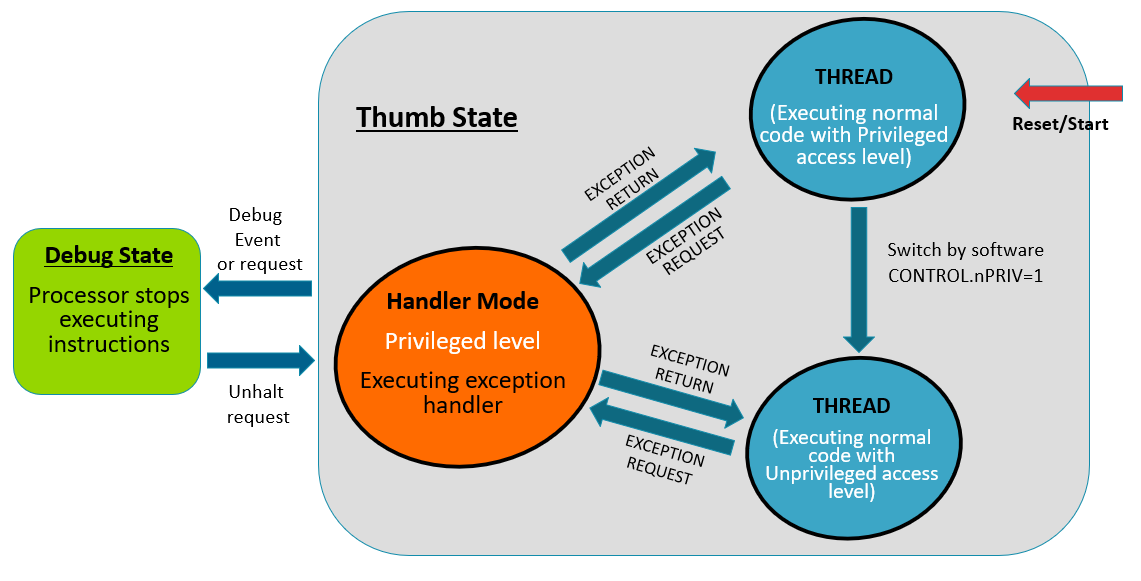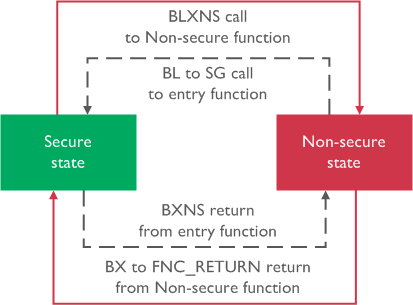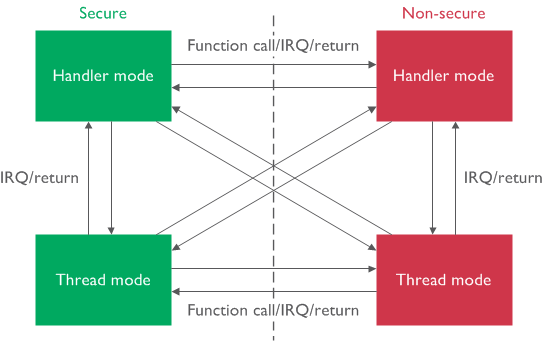Execution Priority
Prface
Cortex-M系列CPU中有handler mode和thread mode,然后又定义了privileged和un-privileged execution,Armv8-M中支持TZ又引入了secure state和non-secure state,再加上exception和interrupt,理解这些模式和了解它们的执行优先级,那么在Cortex-M系列芯片上开发项目的时候会更游刃有余。本文就来理清这些概念和关联。
本文以Armv8-M为例。
PE Mode
Cortex-M有两种PE mode:
- Thread Mode
- 类似Armv8 Cortex-A系列里的EL0,相当于user space,application运行在这个模式下。
- 系统reset后默认进入thread mode。
- Handler Mode
- 同上,类似Armv8 Cortex-A系列里的EL1,主要运行OS kernel,管理系统的资源。
- 所有的exception都是在handler mode下执行。
另外Cortex-M下提供了MSP和PSP(相当于Cortex-A系列中的SP_ELx)在不同场景下使用。
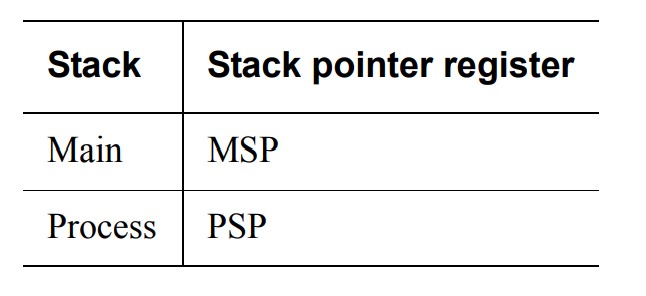
- 在handler mode下,PE always使用MSP(这样在exception发生的时候,保存context会更从容)。
- 而在thread mode下,使用哪个SP则由CONTROL寄存器的SPSEL决定。
- 系统reset后默认使用的是MSP,也就是vector table的第一项(不管是否有security extension)。
Privileged and unprivileged execution
有如下特性:
- Handler mode永远是privileged execution。
- Thread mode则可以运行在privileged或者unprivileged下,由CONTROL寄存器的nPRIV bit配置决定。
- 一些资源只能在privileged下访问(比如设置priority的寄存器)。
Security States
当security extension在Cortex-M中被选用时,PE就有了secure state和non-secure state。
- Secure和non-seucre state下分别都有thread mode和handler mode。如下图
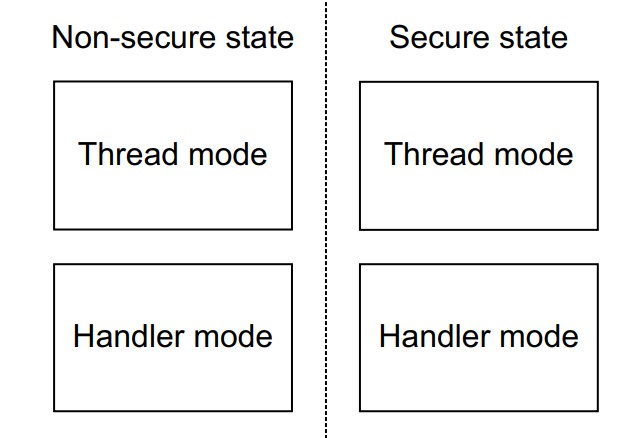
- 和Cortex-A一样,被mark成secure的资源只能在secure state下访问。
- PE在cold reset或者warm reset后进入secure state。
- Warm reset可以通过设置AIRCR的SYSRESETREQ来请求一个system reset,这个bit的权限由SYSRESETREQS来控制是否可以在non-secure state下访问。
- 在做了Warm reset后,一些debug registers会保留reset前的值,其他的和cold reset一样。
- 设置AIRCR的SYSRESETREQ引起的warm reset并不保证立即发生。
- 由于secure state的引入,一些registers就要banked。
- R13(SP) 前面提到,Cortex-M中为PE提供了MSP和PSP两个SP,现在PE分secure和non-secure state,自然为每个state标配一套。其中handler mode还是用MSP,thread mode通过CONTROL寄存器的SPSEL(the bit is banded by security state)选择。
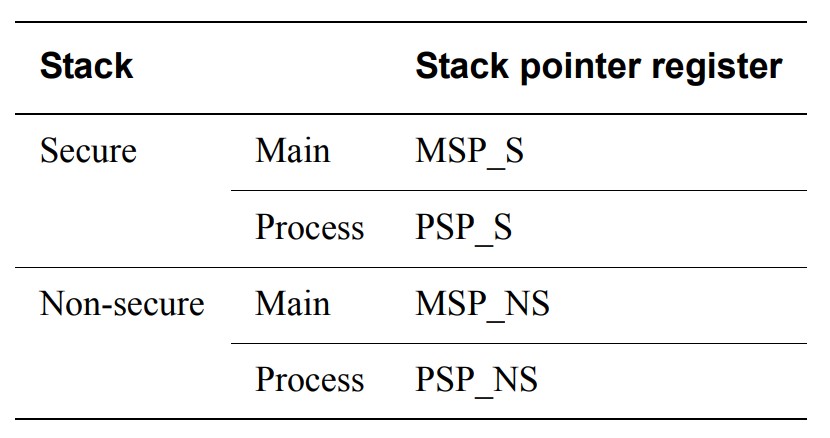
- Special-purpose registers
- PRIMASK, BASEPRI, and FAULTMASK
- CONTROL register
- MSPLIM and PSPLIM
- SCS(System Control Space) The System Control Space (SCS) provides registers for control, configuration, and status reporting。
这些寄存器的命名规则如下:
-
_S The Secure instance of the register -
_NS The Non-secure instance of the register -
访问当前security state的寄存器也可以不带后缀
- R13(SP) 前面提到,Cortex-M中为PE提供了MSP和PSP两个SP,现在PE分secure和non-secure state,自然为每个state标配一套。其中handler mode还是用MSP,thread mode通过CONTROL寄存器的SPSEL(the bit is banded by security state)选择。
- Exception也有部分是banked
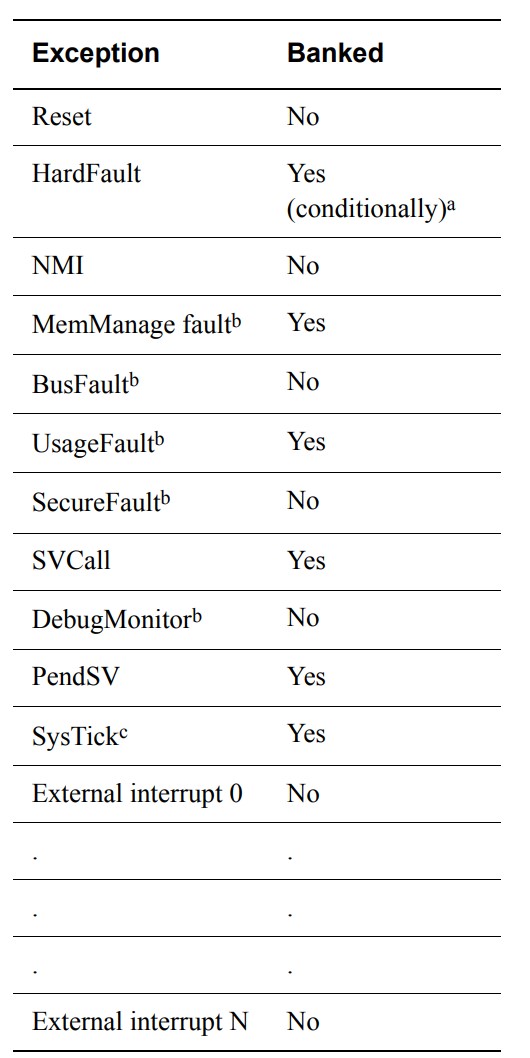
Execution Priority
有了上面的概念,继续看priority是怎么定义的。下表是exception number和priority的对应(with cortex-m main extension):
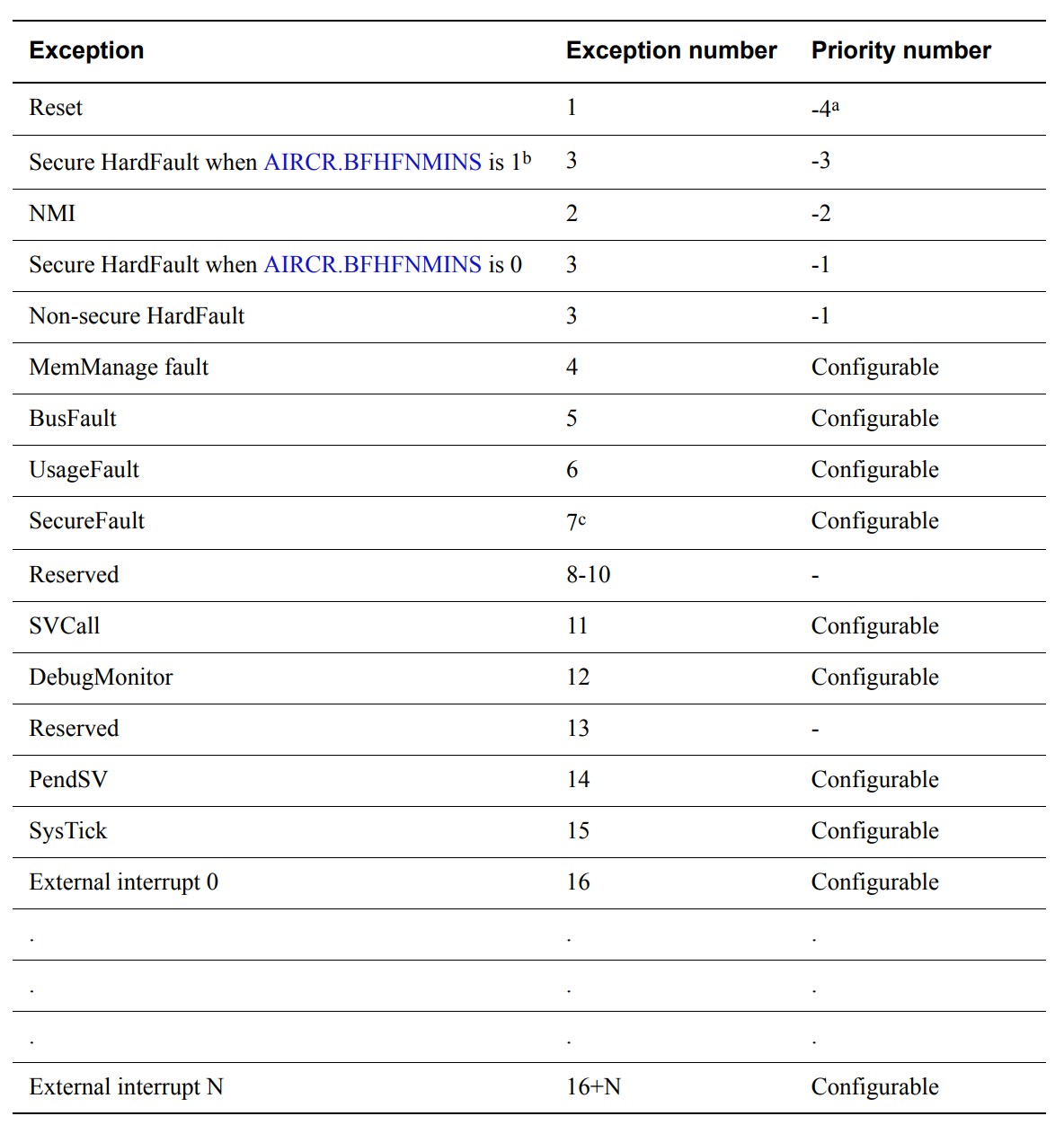
其中标记为Configurable的exception的priority由以下寄存器设置,当然,这些寄存器是privileged access only。


以上皆为secure state下的寄存器,non-secure寄存器的地址则在secure寄存器地址上加一个offset 0x20000。
当AIRCR的PRIS设为1的时候,则non-secure下的priority都要加0x80,意味着non-secure下部分interrupt的priority被降级了。下面是一个例子:
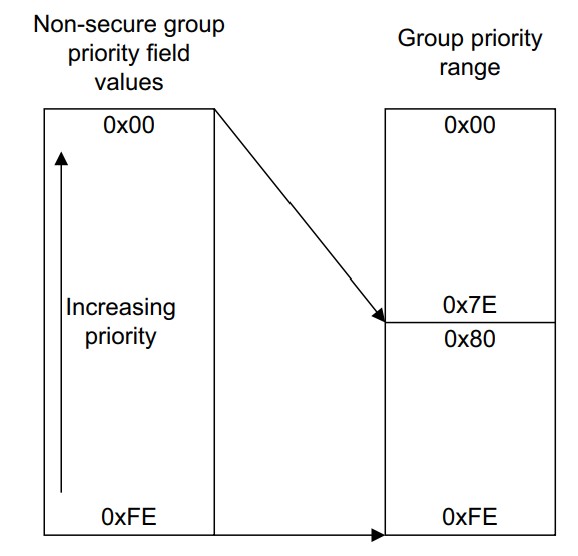
这里有个问题是由于priority bit总共8位,non-secure下0x80到0xFE的加0x80值不变。这个时候不管secure还是non-secure,建议priority设置范围位0到0x7E。这样就可以保证所有的secure下inerrupt的priority是高于non-secure的,当然有特殊场景需求也可以让secure的interrupt priority低于non-secure。
关于exception和interrupt的execution priority都有了结论,那正常运行时候的execution priority是多少呢?Spec上有这样一句话:
When no exception is active and no priority boosting is active, the instruction stream that is executing has a priority number of (maximum supported priority number+1)
也就是在没有exception和特别的priority boost的指令的时候,当前的的execution priority为最低(maximum priority + 1)。这样就保证了priority最低的exception/interrupt也可以执行。(priority boost可以通过设置BASEPRI和PRIMASK来实现。)
Priority Grouping
上文提到exception的priority,由于设置priority的寄存器是每8个bit对应一个exception或者interrupt,这样priority的值就是从0到255,数值越小priority越高。
Priority grouping就是把这8bit分成两部分,分别为group priority和sub-priority。由寄存器AIRCR的PRIGROUP[10:8]来设置。分组如下:
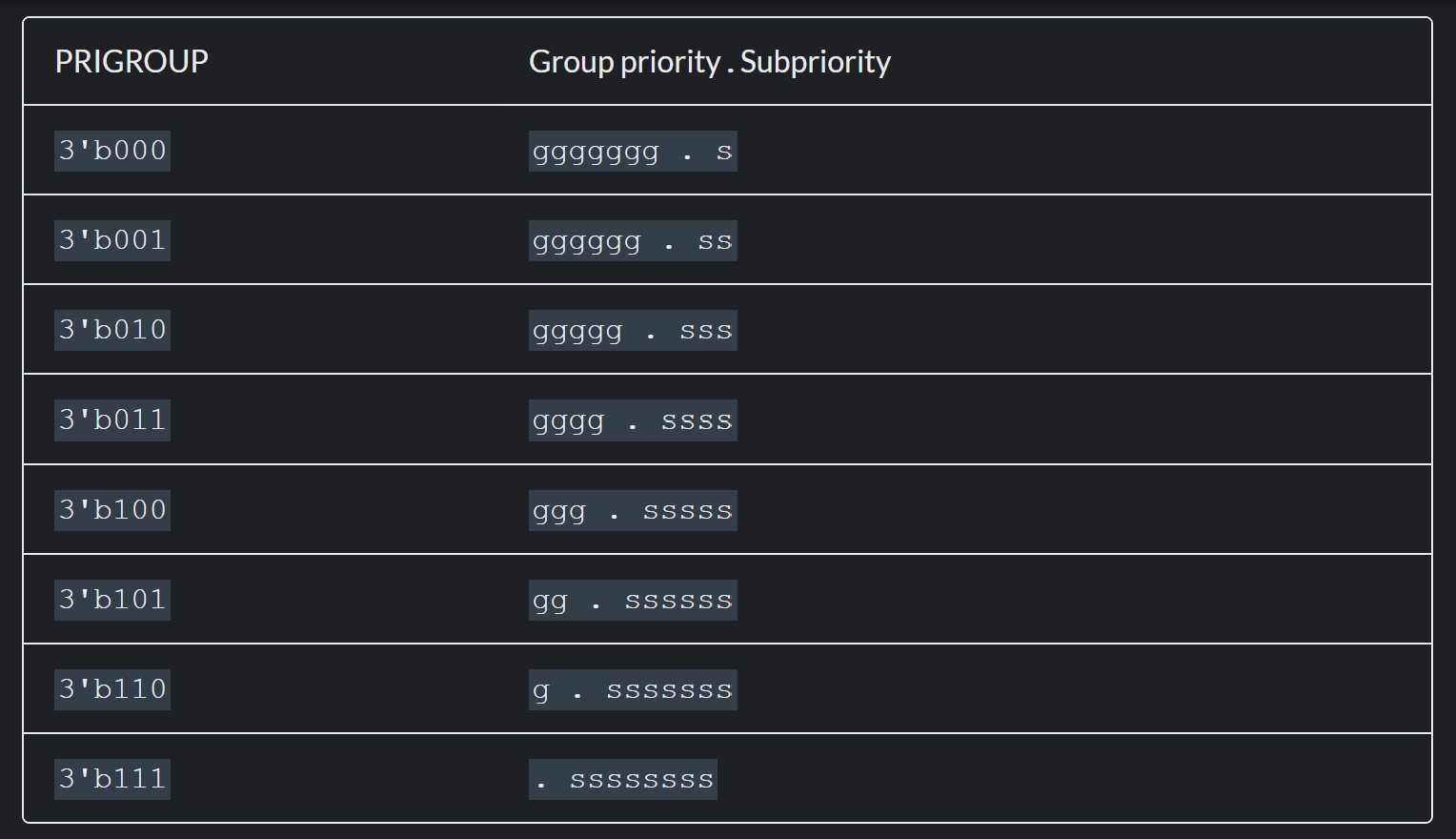
分组的意义在于:
- Group priority高的优先于group priority低的interrupt执行
- Group priority高的可抢占正在执行的group priority低的interrupt
- 在相同的group priority的情况下,subpriority高的interrupt优先执行
- 在相同的group priority的情况下,subpriority高的不能抢占已经在执行的interrupt
在一些芯片的实现里根据需求可能会设计更少的priority bit。比如有效位数为4,则低四位always是0。当分组决定group priority的位数大于等于4的时候,则只有group priority起作用。
另外需要注意的是在一些实现中通过设置PRIMASK来enable和disable interrupt,根据spec描述该bit设为1时“Boosts execution priority to either 0 or 0x80.”,也就是把当前execution priority提高到最高的0或者080(non-secure),这时候interrupt还是会来的,只是处于pend状态,等把PRIMASK再次设为0的时候,之前pending的interrupt仍然会被处理。
使用BASEPRI也是一样,它只是“changes the priority level required for exception preemption”,并没有真正禁止interrupt。
Execution Priority Transition
这节看下各种模式之间如何转换。
Handler mode and thread mode
By default, the Cortex-M processors start in privileged Thread mode and in Thumb state. In many simple applications, there is no need to use the unprivileged Thread model and the banked SP at all.
因为Cortex-M加电后首先进的是reset vector,博主一直以为是handler mode,然而从spec看,却是privileged thread mode。下面这张图更清晰的描述了它们之间的转换。
上文提到handler mode运行OS kernel,thread mode运行application,但从FreeRTOS的实现看来并非如此。Exception和interrupt运行在handler mode这个毫无疑问。FreeRTOS中OS Kernel则运行在privileged thread mode。这点在SVC call的进入vSystemCallEnter和推出vSystemCallExit两个函数的实现得到了体现。task则根据参数可运行在privileged thread mode和unprivileged mode。
Privileged and unprivileged
如前所述,Armv8 Cortex-M spec上虽然讲handler mode下运行“OS kernel and associated functions, that manage system resources. ”,然后从实际操作来看,其实是privileged mode运行OS kernel。它们之间的切换在上图中得到了体现。这里不做赘叙。
Secure state and non-secure state
把exception和interrupt加进来就更复杂了。
State transitions can also happen due to exceptions and interrupts. Each interrupt can be configured as Secure or Non-secure, and is determined by the Interrupt Target Non-secure (NVIC_ITNS) register, which is only programmable in the Secure world. There are no restrictions regarding whether a Non-secure or Secure interrupt can take place when the processing is running Non-secure or Secure code.
各种模式之间的切换本质上都是execution priority的改变。关于这部分的实践,建议选取某个RTOS进行代码研读,以便加深理解。
Reference
Armv8-M Architecture Reference Manual
Exception priority level definitions
Priority grouping
Interrupt priority grouping
Operation Modes and States
Switching between Secure and Non-secure states
